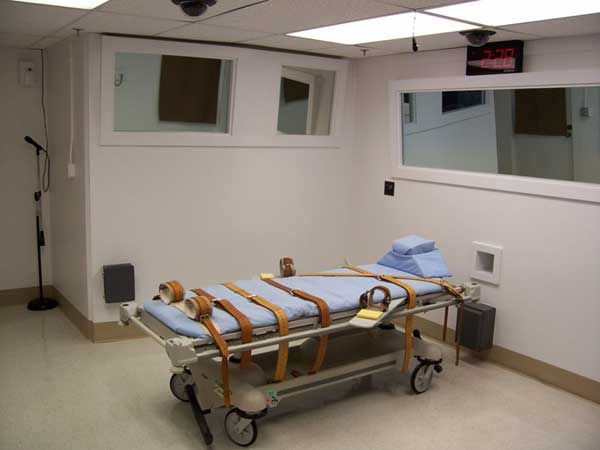Death and Medicine: Why Lethal Injection Is Getting Harder

A controversial drug used in lethal injections will not be banned for use in the death penalty in the United States. A Supreme Court decision yesterday (June 29) found that the sedative had not been proven more "cruel and unusual" than the alternatives.
The drug, midazolam, is just the latest to fall under scrutiny as more and more of the drugs used in the death penalty become unavailable, pulled from sale to prisons by manufacturers who don't want their products associated with execution. As a result, corrections facilities have been facing shortages of lethal injection drugs for years.
Improvising on the fly, prisons have tried various drug cocktails, botching some executions in the process. In January in Ohio, for example, condemned murderer Dennis B. McGuire gasped and choked for 25 minutes before expiring. Midazolam was used in that execution. The same drug was used in an execution in August 2014 in Arizona in which the condemned took almost two hours to die. [Mistaken Identity? 10 Contested Death Penalty Cases]
Supply and demand
In comments sections on articles about these drawn-out spectacles, one question comes up again and again: Why is it so hard to kill someone via lethal injection? After all, veterinarians manage to euthanize pets rapidly every day, with minimal discomfort. Why aren't those drugs used in executions?
Prison officials think the same way. The problem, however, is not that these drugs can't be used on humans, for the most part. It's with supply. Nearly every drug that prison officials turn to for lethal injections has been restricted from that use by manufacturers.
Traditionally, lethal injections have used a three-drug cocktail: sodium thiopental for sedation, pancuronium bromide to paralyze the muscles and potassium chloride to stop the heart. In 2011, however, Hospira Pharmaceuticals, the only U.S. manufacturer of sodium thiopental, stopped making the drug because of its use in executions. That same year, the European Union banned the export of sodium thiopental as well as other barbiturate drugs used in executions, ruling that companies had to ensure any exports would not be used for lethal injections. [How Does Execution Drug Midazolam Work?]
Sign up for the Live Science daily newsletter now
Get the world’s most fascinating discoveries delivered straight to your inbox.
Pentobarbital, the barbiturate often used in animal euthanasia, was covered under the ban. (The drug is also used in physician-assisted suicides in the Netherlands and in Oregon.) Fourteen states have used the drug in executions, according to the Death Penalty Information Center, which advocates against capital punishment. But supplies of the drug are limited. Some states, including Texas, have turned to anonymous compounding pharmacies, which custom-make medications, to get the drug.
Another common drug used both in human anesthesia and in veterinary medicine is propofol, which is not a barbiturate. Missouri planned to use this drug in lethal injections, but the EU threatened to end exports to the United States, and the state's plan was scrapped.
First, do no harm
The supply problem highlights a long-standing issue with the medicalization of the death penalty: Doctors are not, generally speaking, on board. The American Medical Association (AMA) opposes physician involvement in capital punishment, as does the American Board of Anesthesiology (ABA).
"Patients should never confuse the death chamber with the operating room, lethal doses of execution drugs with anesthetic drugs, or the executioner with the anesthesiologist," J. Jeffrey Andrews, the secretary of the ABA, wrote in a commentary in May 2014. "Physicians should not be expected to act in ways that violate the ethics of medical practice, even if these acts are legal. Anesthesiologists are healers, not executioners."
While prisons can often find physicians to preside over executions, the involvement of the medical profession in executions does not always proceed smoothly. In 2006, executions in California halted when two anesthesiologists resigned from participation in the execution of Michael Morales. They quit after finding out that they would be expected to intervene directly if the execution procedure went wrong.
"The Morales case unearthed a nagging paradox. The people most knowledgeable about the process of lethal injection — doctors, particularly anesthesiologists — are often reluctant to impart their insights and skills," wrote Deborah Denno, a professor at the Fordham University School of Law, in a 2007 paper on medicine and the death penalty.
A doctor was presiding over the June 2014 execution of Clayton D. Lockett, who died of heart failure 43 minutes after Oklahoma prison officials began his execution. But a medical technician was doing the actual procedure. Witnesses reported that it took nearly an hour of poking and prodding before the technician gave up on setting a catheter in Lockett's arms, legs or feet, and instead tried to place a line through the femoral artery. An independent autopsy commissioned by the condemned man's lawyers found that the line was not placed properly, perhaps explaining why Lockett appeared to wake up after the first sedative drug was injected.
Execution alternatives
The Supreme Court's pass on midazolam may be moot. In February, a major manufacturer of the sedative told the Anniston Star newspaper of Anniston, Alabama, that it disapproved of the use of its drug in executions and would not sell midazolam to the prison system or to middlemen who sell to prison officials. The paper reported that of eight other companies that make the drug, at least six have policies in place to prevent the substance's use in executions.
If botched executions and drug shortages continue, the future of capital punishment is unclear. Tennessee allows the use of the electric chair if lethal injection drugs run out; Utah allows the firing squad. Starting in November, Oklahoma will use nitrogen gas asphyxiation as its backup method. This method works by displacing oxygen in the lungs, causing rapid unconsciousness and then death. Nitrogen inhalation has never been used as an execution method, but scuba divers exposed to excess nitrogen while diving often report feeling giddy.
Electrocution was originally devised as a humane approach to hanging, but after executions that required multiple jolts of electricity and occasionally resulted in flames and smoke, the method fell out of favor. Nebraska, the last state to use the electric chair as its only method of execution, declared electrocution unconstitutional in 2008. Some states allow inmates to choose this method of death; the last to do so was Robert Charles Gleason, Jr., executed in Virginia in January 2013.
Utah banned death by firing squad in 2004, though one inmate, Ronnie Lee Gardner, died that way, in 2010. Gardner was sentenced before the ban, and thus was allowed to choose the firing squad as his method of death. In March 2015, however, Utah reinstated the firing squad in the event that lethal injection drugs become unavailable.
Follow Stephanie Pappas on Twitterand Google+. Follow us @livescience, Facebook& Google+. Original article on Live Science.

Stephanie Pappas is a contributing writer for Live Science, covering topics ranging from geoscience to archaeology to the human brain and behavior. She was previously a senior writer for Live Science but is now a freelancer based in Denver, Colorado, and regularly contributes to Scientific American and The Monitor, the monthly magazine of the American Psychological Association. Stephanie received a bachelor's degree in psychology from the University of South Carolina and a graduate certificate in science communication from the University of California, Santa Cruz.











